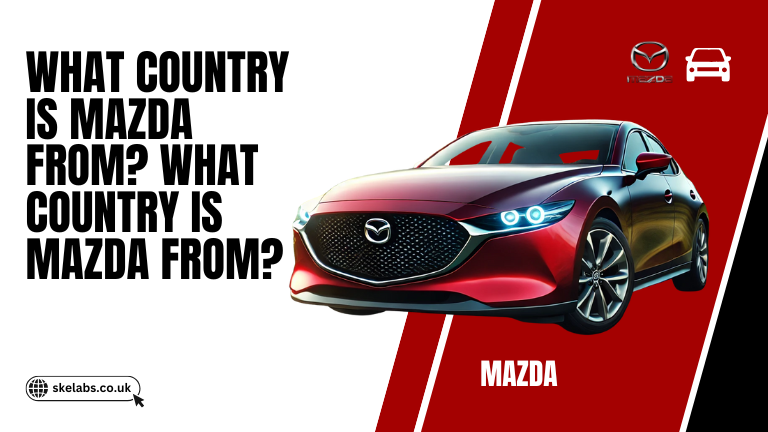Mazda is a brand synonymous with style, performance, and innovation in the automotive industry. Its rich history dates back to Japan. Mazda is an iconic car manufacturer whose global presence continues impressing car enthusiasts around the world. This article will provide an overview of Mazda’s history, technological advances, global impact and more.
Where does Mazda come from?
Mazda hails from Japan and specifically Hiroshima Prefecture. Fuchu is the company’s headquarter, which is a district in Hiroshima. Mazda was founded in 1920 as Toyo Cork Kogyo Co. Ltd. Its main business was manufacturing cork. The company began producing three-wheeled cars in 1931, but it wasn’t until then that they ventured into automobile manufacturing. Mazda has evolved over time into a globally recognized car manufacturer for its stylish designs and cutting-edge technologies.
User query: Where are Mazda headquarters located?
Mazda Motor Corporation headquarters in Hiroshima are not only a hub of production, but also a sign of the company’s growth and resilience. Hiroshima’s historical importance is a major factor in the choice. The region also continues to be an important center for automotive manufacturing and innovation in Japan.
A brief History of Mazda

User query: What year was Mazda founded?
Jujiro Matshida founded Mazda officially on January 30th, 1920, originally as Toyo Cork Kogyo Co., Ltd. In 1931, however, the company began to focus on automobile production. The Mazda-Go was their first vehicle, a three-wheeled pickup truck that was designed to meet the needs of local business. Mazda was at a turning point in its history. The company’s growth into a global automotive giant began with this moment.
Who founded Mazda
Jujiro Maatsuda was the visionary founder of Mazda. He shifted his focus from cork manufacturing to automobile production. The early years were shaped by his ambition and vision. “Mazda”, the name of the company is derived both from Ahura Mazda (the god of harmony) and Matsuda’s last surname.
What does Mazda mean?
User query: What is Mazda?
Mazda has several symbolic meanings. It is derived from Ahura Mazda in Zoroastrianism which represents harmony. However, it also pays tribute to the founders last name Matsuda. Name reflects brand’s goal to establish a harmonious relationship among people, automobiles, and the environment. The deep meaning of the name Mazda helps it maintain a relationship with its customers and promote its legacy in intelligent design, technological innovation, and sustainability.
Mazda’s Key Innovations
Mazda is known for its innovative automotive technologies and design philosophy. Mazda has been shaped by some major innovations.
- SkyActiv Technology
User query: SkyActiv technology:
SkyActiv is Mazda’s suite of innovative technologies that are designed to improve the performance and efficiency of Mazda vehicles. SkyActiv was introduced in 2011 and focuses on fuel efficiency without compromising the performance. SkyActiv includes new engine, transmission, chassis and body designs that work together to achieve better fuel economy and lower emission levels. - Wankel Rotary Engine
Mazda is known for its Wankel rotary engines. The Wankel engine, unlike conventional piston engines uses a triangular rotating rotor that converts pressure into rotational movement. The engine is known for its smooth operation and compact size. It has also been a trademark of Mazda’s engineering expertise, especially in models such as the RX-7 or RX-8. - Kodo Design Philosophy
User Query Mazda’s Design Philosophy
Mazda’s Kodo, or “Soul of Motion” design language reflects its commitment to create cars with dynamic energy. This design philosophy emphasizes movement even when the vehicle is at rest. This philosophy is perfectly exemplified by the flowing lines, aggressive posture, and sculptural bodies of the Mazda3, CX-5 and MX-5 Miata.
Mazda’s Global Presence
Mazda has grown to be a global brand, not just a Japanese one. The vehicles of the company are sold in many countries around the world and its manufacturing footprint also is extensive.
User query: Where do Mazda cars sell?
Mazda sells cars in more than 130 countries, including the United States, Europe and China. Mazda cars are known for their performance, affordability, and design.
User query: How may countries produce Mazda vehicles?
Mazda has manufacturing plants in Japan as well as Mexico, Thailand and other places. Mazda’s ability of producing vehicles in different regions allows it to meet local market demands efficiently.
Also Check: Is Caring for Your Elderly Mother Taking Over Your Life?
Mazda Commitment to Sustainable Development
Mazda is increasingly focused on sustainability, both in terms of its production processes and vehicle design. The company has committed to reduce its carbon footprint, and to invest in alternative technologies.
User query: Does Mazda have an environmentally friendly policy?
Mazda is committed towards environmental sustainability. The company is focused on improving fuel efficiency, reducing CO2 emission, and developing hybrid and electric vehicles. Mazda’s MX-30 was the first completely electric vehicle launched by the company in 2020, as part of its efforts to reduce the environmental impact.
Mazda Models
User query: Which Mazda models are most popular?
Mazda’s best-selling models include:
- Mazda3 – Mazda3 is known for its compact size and outstanding performance.
- Mazda CX-5 – A stylish and efficient crossover SUV
- Mazda MX-5 Miata : A roadster renowned for its agility.
Mazda Logo and Branding Evolution
Mazda’s logo has changed significantly since its inception. The Mazda logo, which was originally a simple design with a single color, now represents the innovative spirit of the company and its global appeal.
User Query What is Mazda’s symbolism?
Mazda’s current logo represents the brand’s commitment to innovation and excellence. The winged design is a symbol of Mazda’s dynamic nature and serves as a visual representation for Mazda’s forward movement.
FAQs
Where is Mazda from?
Mazda is from Japan, with its headquarters located in Fuchū, Hiroshima Prefecture.
What does the Mazda logo represent?
The Mazda logo symbolizes innovation, with its winged design representing the brand’s dynamic and forward-thinking approach to automotive manufacturing.
Is Mazda environmentally friendly?
Yes, Mazda is committed to sustainability, focusing on reducing CO2 emissions, developing fuel-efficient vehicles, and producing electric and hybrid models like the Mazda MX-30.
Conclusion
Mazda’s transformation from a cork manufacturer to a global icon of automotive design is a testament of its innovation, resilience and commitment to quality. Mazda’s rich history, innovative technologies such as SkyActiv and Wankel engines, and vision for a sustainable tomorrow continue to impress loyal customers and new enthusiasts. Mazda’s influence on the auto industry is unquestionable, whether you are interested in its cutting-edge design philosophy, or the latest eco-friendly models.
Mazda will continue to be a major player in the automobile industry as it continues to develop, combining performance, design and sustainability into every vehicle that it produces.

